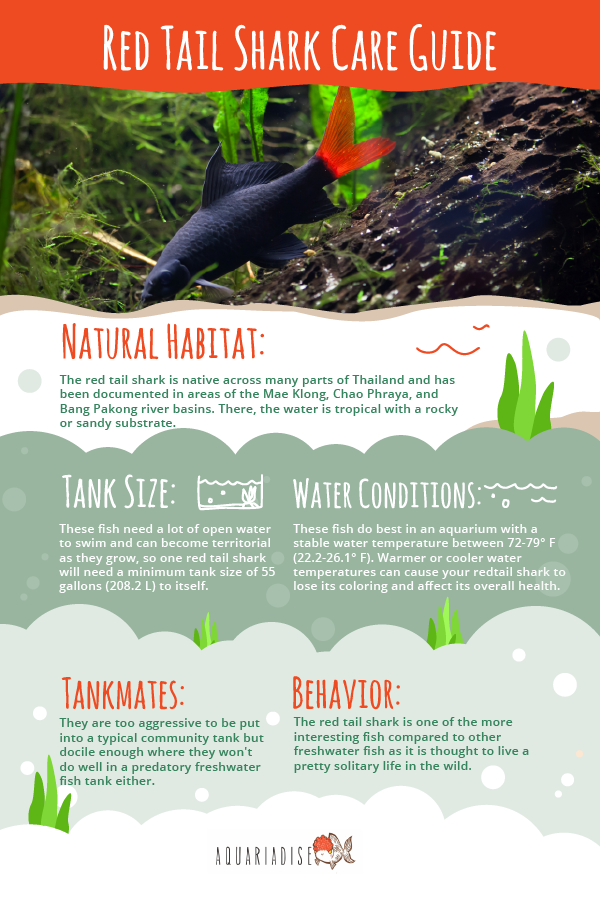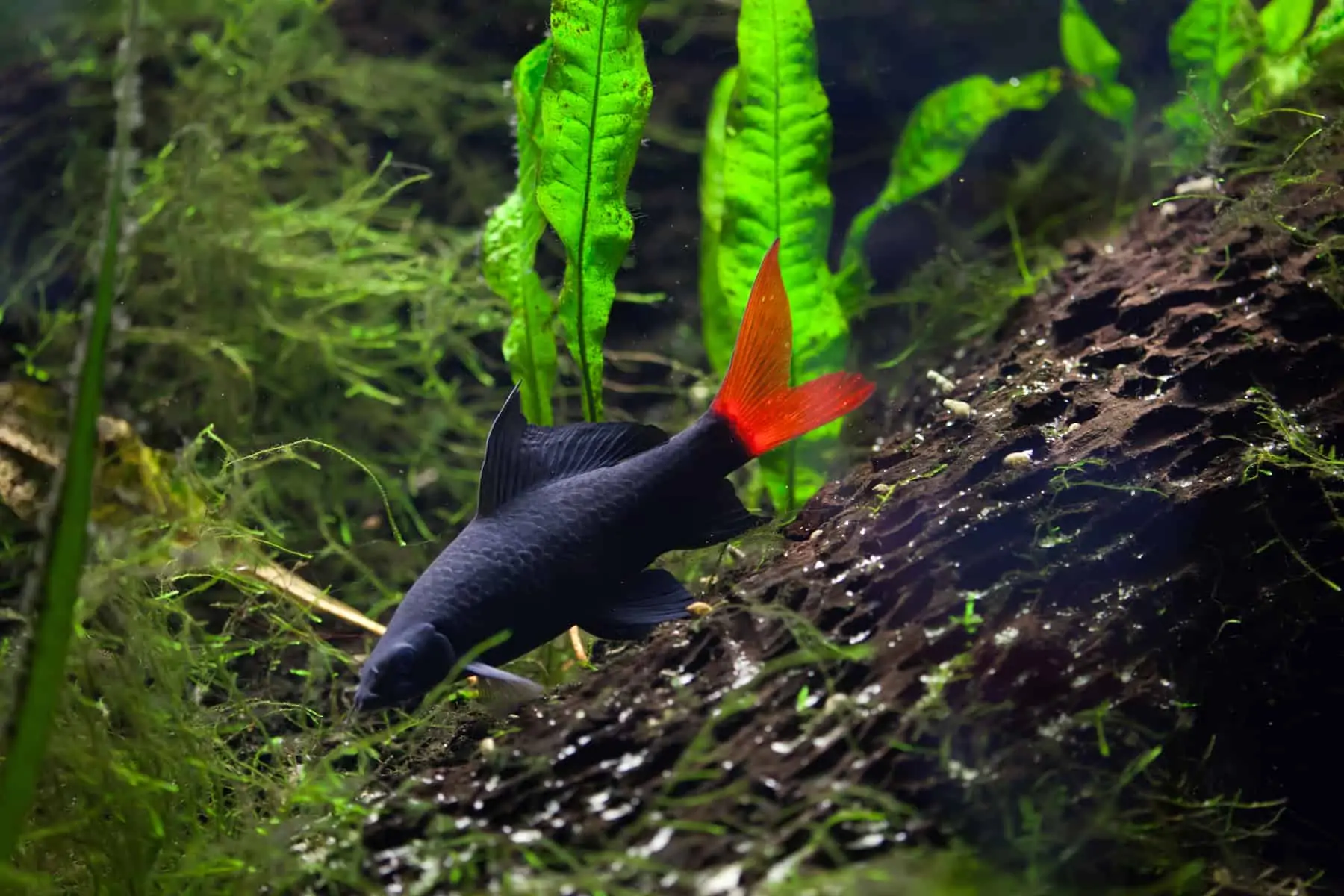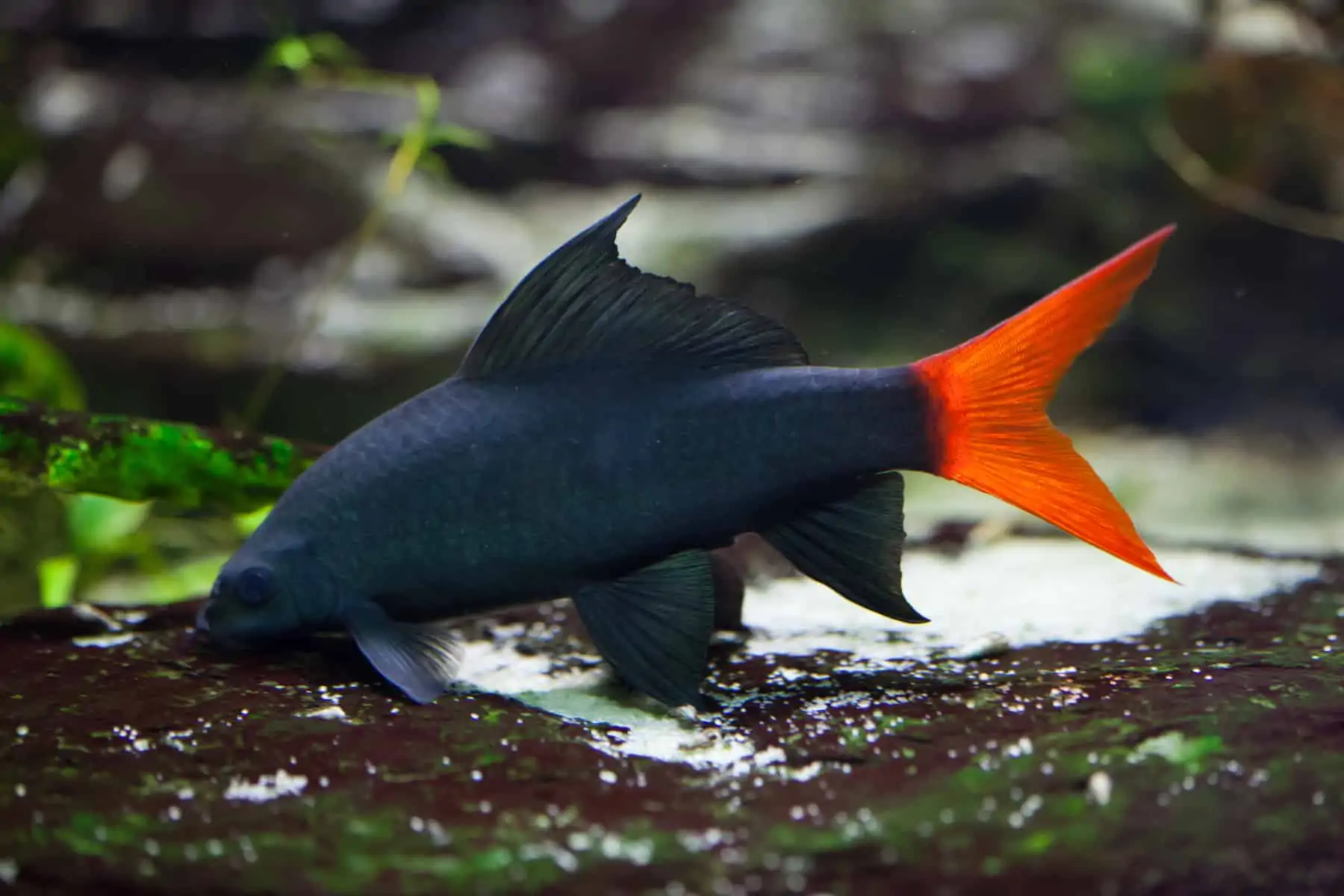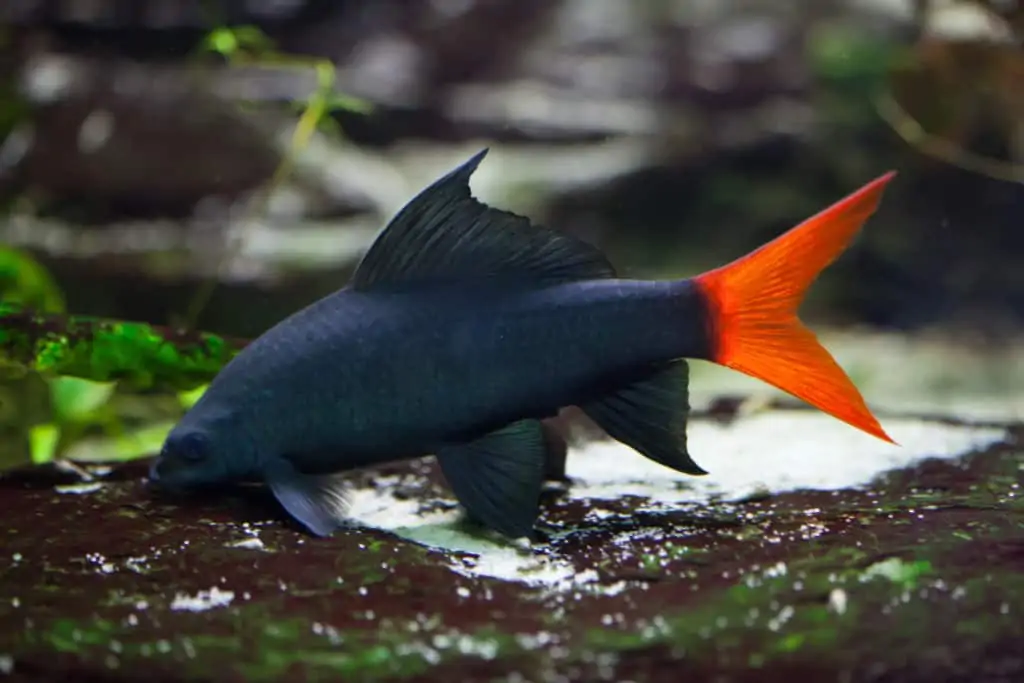There are species upon species of colorful fish available in the aquarium trade, but nothing quite matches the unparalleled simplicity of the red tail shark. These striking black and red-tailed fish are a favorite for many, but unfortunately, little is actually known about the proper care they require to thrive in the aquarium; however, it is known that they tend to be semi-aggressive towards tank mates and that only one red tail shark can be kept per tank for the most part.
Keep reading to find out everything you need to know about red tail shark care and keeping this black shark in your own aquarium!

Name
Epalzeorhynchos bicolor is also known as the red tail shark, red tailed shark, red tail black shark, or red tail sharkminnow. Red tail sharks were originally categorized in the Labeo genus, which is the genus that houses carps, as Labeo bicolor in 1931. They have since been moved to the ‘freshwater shark’ genus, Epalzeorhynchos. However, the categorization of Epalzeorhynchos bicolor is still under consideration.
While labeled as a ‘shark,’ these freshwater fish are not even remotely related to the typical shark seen scanning the ocean floor; red tail sharks are ray-finned bony fish (class Actinopterygii) while sharks are cartilaginous fish (class Chondrichthyes).
Natural habitat
The red tail shark is native across many parts of Thailand and has been documented in areas of the Mae Klong, Chao Phraya, and Bang Pakong river basins. There, the water is tropical with rocky or sandy substrate. Sadly, these areas have become highly polluted due to agricultural and domestic input. The red tail shark was also a popular aquarium trade export, which further hurt the wild populations of this black shark.
These two factors led to the red tail shark being labeled as extinct in the wild in 1996. It wasn’t until 2011 that a small population was found in the Chao Phraya basin. Since then, they have been placed as a critically endangered species on the IUCN Red List of Threatened Species, though it is not known if there are any red tail sharks actually still left in the wild as of early 2020.
Identification
While the red tail shark is only two colors, it can actually be a little difficult to correctly identify. Red tail sharks can grow up to 5-6 inches (12.7-15.2 cm) long. These fish are named after the resemblance that their dorsal fin has to that of more conventional sharks. Their body is long and sleek and they will have two barbs on either side of their downward-pointing mouth.
Most notably, hobbyists favor this black shark with red tail for its simple yet statement colors. They have a sleek matte black body and a flaming red tail fin. If your red tail shark becomes stressed for any reason, these colors will often fade, especially from the tail.
However, red tail sharks are often confused with and misidentified as rainbow sharks. This is what to look for if you’re trying to differentiate the two species:
Rainbow shark (Epalzeorhynchos frenatum). The rainbow shark is in the same genus as Epalzeorhynchos bicolor and comes from the same river basins and ecosystems. They are also most commonly known as the red-fin shark, red-finned shark, rainbow sharkminnow, and ruby shark.
The rainbow shark can also grow to about 6 inches (15.2 cm) long, but there are a few key differences between Epalzeorhynchos frenatum and Epalzeorhynchos bicolor. Rainbow sharks are also long and slim with a pointed snout and have two barbs by their downward-point mouth. They can have a dark blue, light blue, or black body.

The one main way to tell these two fish apart though is by looking at their fins. Rainbows sharks will have red-orange pectoral, dorsal, ventral, anal, and caudal fins; the only red-orange fin that a red tail shark will have is their caudal fin. Interestingly, it is believed that the two species have since been bred to create a hybrid variation since entering the aquarium hobby.
Also, make sure that you can correctly identify each fish as their aquarium temperaments differ as well. Epalzeorhynchos frenatum is a bit more suited for the typical community tank and favors algae more than Epalzeorhynchos bicolor, but we’ll get deeper into red tail shark behavior later.
Note: Rainbow sharks also come in an albino variation where the body will be white and the fins will be a more faded orange. Because of these, they have unfortunately become subject to artificial dye injection.
Sexual dimorphism
Red tail sharks aren’t the easiest to tell apart, but it’s definitely possible in time. If you buy these fish while they’re still juveniles, there are no clear differences between the male and female fish. However, as they grow, females will get much more stocky- and fuller-looking than males.
How long do red tail sharks live?
Because there is not a lot of research concerning their natural habitats, these fish have been blindly bred and sold for decades. It is thought that red tail sharks can easily live up to 15 years in a stable aquarium with pristine water and tank conditions. However, it is much more likely to have your shark only live for 6 of those years.
Red tail shark tank requirements
Since there is not a lot of information about red tail sharks available, how can you make them the happiest that they can possibly be in your tank?
Your aquarium should try to represent the natural river conditions that these fish would normally be found in, before the pollution. These fish need a lot of open water to swim and can become territorial as they grow, so one red tail shark will need a minimum tank size of 55 gallons (208.2 L) to itself.
Water flow should be moderate to high, as long as it is not so strong that it is pushing your shark or your substrate around! The water should also have a relatively high level of dissolved oxygen in it, which can be achieved by more surface water agitation or air stones.
The substrate should be a natural mix of sand, gravel, and smooth rocks. They will also appreciate a lot of places to hide throughout the tank, like caves made out of driftwood. Make sure that there are no sharp corners or edges in your aquarium as your fish will like to perch on different objects in the tank and sift through the substrate; you don’t want your fish to scrape its body and get injured anywhere!
One of the great things about these fish is that while they will eat algae, they will most likely not touch any of the live plants that you have in your tank! These fish need moderate lighting as either extreme will make your fish lose its signature coloring, so good plants would be moderate-demanding species, like Anubis and Amazon sword (Echinodorus grisebachii).
If you’re just starting to think about introducing live plants into your tank, find our “How to set up a low-tech planted aquarium” guide here.
Also, make sure to cover your aquarium with a hood as these fish are very aerodynamic and can easily catapult themselves out of the tank.
Water conditions
These fish do best in an aquarium with a stable water temperature between 72-79° F (22.2-26.1° F). Warmer or cooler water temperatures can cause your redtail shark to lose its coloring and affect its overall health.
pH should be between 6.5 and 7.5 with neutral water being the most preferred.
Red tail shark tank mates
It can be a little difficult to find the best tank mates to keep with your red tail shark due to their temperament. They are too aggressive to be put into a typical community tank but docile enough where they won’t do well in a predatory freshwater fish tank either.
What fish are compatible with red tail sharks?
Despite being a little more aggressive, the red tail shark can still go with a whole assortment of fun and colorful freshwater fish. Here are some tank mates that you could consider keeping in your semi-aggressive community tank:
Bala shark (Balantiocheilos melanopterus). These endangered fish are a striking metallic silver with black-rimmed fins. However, they can grow up to 14 inches (35.6 cm) long and like to shoal together in groups of at least 5 in order to keep aggression down.
Gouramis. There are many different kinds of gourami, but you should choose the larger species to prevent your red tail shark from stressing the fish. One of the most kept tank mates is the three spot gourami (Trichopodus trichopterus). These fish can grow between 5-6 inches (12.7-15.2 cm) and can also come in a variety of colors.
Angelfish (Pterophyllum scalare). Surprisingly, many hobbyists have great success keeping angelfish with their red tail shark. Angelfish can get to be 6 inches (15.2 cm) across, with their draping fins adding additional height that should be considered for tank dimensions.
Cherry barbs (Puntius titteya). Cherry barbs are a better alternative to the popular tiger barbs (Puntigrus tetrazona) as they do not get as aggressive and do not tend to nip at as many fins. These fish can grow up to 2 inches (5 cm) long and will also need to be kept in schools of at least 5 or more.
Tetras. With so many different species of tetra to choose from, which are the perfect tank mates for your red tail shark? Like gouramis, it is better to go with the bigger ones that can get away from your red tail shark if need be. Most hobbyists like to go for black skirt tetras (Gymnocorymbus ternetzi), emperor tetras (Nematobrycon palmeri), or cardinal tetras (Paracheirodon axelrodi). These fish will stay under 4 inches (10.2 cm) and also need to be kept in schools. It will help if these schooling fish are kept in bigger groups especially since the tank size allows for it; there is definitely security in numbers!
Larger and more aggressive fish, like cichlids, will be too aggressive for your red tail shark. Other freshwater fish that live in cooler or warmer water will also be incompatible as your shark will not thrive outside of its optimal water temperature range. They should not be housed with any fish that look like them as this is when these sharks get especially aggressive.
Remember, each fish has its own personality and some tank mates may be more successful than others. Never introduce a fish into your red tail shark aquarium that you are afraid of potentially losing.
How many red tail sharks can you keep together in your aquarium?
These fish tend to be very aggressive and territorial towards the same species of fish, as well as fish that have the same body structure and similar colors; most hobbyists only keep one in their minimum tank size of 55 gallons (208.2 L). However, if the tank size was doubled to 125 (473.18 L) and lots of extra hiding spots were added, then it might be possible to house two red tail sharks in the same large aquarium.
Always remember that no two fish have the same temperament, and one might take better to the same species than the other. If you’re not willing to set up another tank or rehouse your red tail shark if things go badly otherwise, then do not try to put more than one in the same aquarium.
Also, remember that their aggression level increases with their size and age. Juveniles might get along well in a large aquarium, but it could quickly turn into a problem overnight.
Red tail shark behavior
The red tail shark is one of the more interesting fish compared to other freshwater fish as it is thought to live a pretty solitary life in the wild; the only other time that one red tail shark would come in contact with another red tail shark is during spawning periods.
Are red tail sharks aggressive?
These fish are labeled as semi-aggressive in a tank setting, with the exact level of aggression varying from fish to fish. They are especially aggressive towards their species and similar-looking fish as they tend to never come in contact with them in the wild.
Do red tail sharks eat other fish?
The red tail shark has a very little mouth and is a scavenger by nature, meaning that they will eat (or are at least willing to try) anything they might come across in the water column. Does this mean that your red tail shark will purposely stalk and hunt down the other freshwater fish in your aquarium? Most likely, no.
It isn’t that red tail sharks hurt other fish by hunting them, but rather, that they stress them out to the point where they are susceptible to disease and infection. They may also die from pure exhaustion.

Red tail shark diet
The red tail shark is an omnivore, meaning that these fish will need a healthy balance of plant- and animal-based foods; they have a scavenger instinct and will most likely willingly accept any food that is placed in the tank.
These fish have a downward-pointing mouth, meaning that they get most of their food from the substrate and other surfaces where particles have fallen. This means that it is not likely for your red tail shark to leave the lower and middle water column while feeding as they will probably wait for the food to come to them; make sure that enough food is reaching the bottom of the tank and doesn’t get eaten by other fish first.
Make sure to provide your fish with a variety of live foods, frozen foods, and blanched vegetables. Food should be of high quality to maintain the health and color of your fish. Try offering your fish food like:
- Brine shrimp
- Bloodworms
- Insect larvae
- Algae wafers
- Fish flakes
- Vegetables ( like cucumbers, shelled peas, and lettuce)
Because it can be difficult to get a consistent and trustworthy supply of live foods sometimes, many hobbyists turn to cultivating their own aquarium food. If you’re interested in trying to start your own live food farm, make sure to check out our guide on brine shrimp here.
Algae eaters
While these fish will eat algae and other vegetation, they should not be used as an algae control for the aquarium. Remember, one of these fish already needs a large tank to itself; one red tail shark will not be able to singlehandedly tackle an algae problem! There are much better alternatives if you have a large enough tank, like Otocinclus catfish or the Siamese algae eater (Crossocheilus siamensis).
Note: Never purchase a fish or other aquatic life as a temporary solution to an algae problem in your tank if you cannot house the fish indefinitely. It is always better to assess water quality issues than to introduce more bioload into the tank.
Breeding red tail sharks
Unfortunately, the red tail shark has not been bred within the home aquarium as of yet. This is due to the high aggression that these fish have towards each other and many hobbyists simply not having the tank space to allow these fish their own territories.
Because they are nearly extinct in the wild, little is known about their natural breeding behaviors in the tank setting. It is known that these fish are egg layers and spawn in cave systems. After fertilization, the eggs hatch after a couple of days and then become free-swimming shortly after. They start as a lighter and more silver color, and then slowly transition to their stark black coloring. Their red tail also starts to get color after about 2 months.
But if they are extinct in the wild, how does the aquarium trade have so many of these fish? Large commercial aquarium farms have the ability to breed red tail sharks, most likely through the use of hormones. Unfortunately, these efforts most likely cannot be used to rehabilitate or revive wild populations as their natural conditions have not improved and the instincts and integrity of the fish may have been compromised.
Conclusion
The endangered red tail shark may have the dorsal fin of a real shark but these relatively small fish have a much easier care level! While only one fish can be kept in an aquarium for the most part, they don’t require any special water parameters or diet. Tank mates should be chosen with care and these fish should never be used for algae control purposes.
However, if you have the space and are looking to bring some excitement to the bottom of your tank, then the red tail shark is definitely one fish to consider.
If you have any more questions about the red tail shark or have kept one of these beautiful black sharks in your own aquarium, make sure to leave a comment below!


